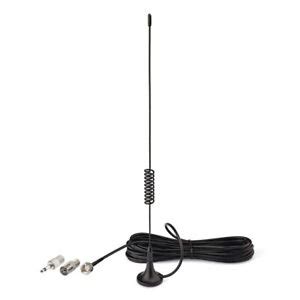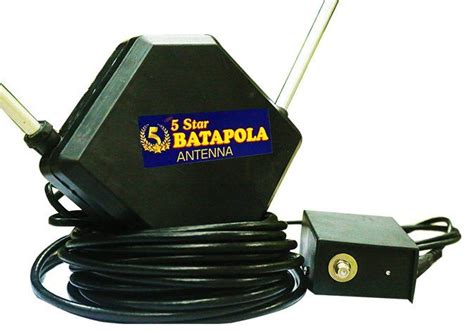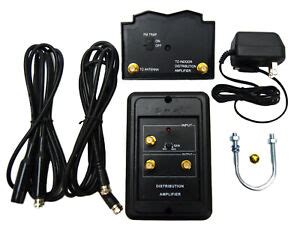Introduction to FM Antenna Boosters
An FM antenna booster, also known as an FM Signal amplifier, is a device that helps improve the reception of FM radio signals. It works by amplifying the weak signals received by your FM antenna, making it easier for your radio to pick up stations that might otherwise be difficult to receive. This can be especially useful if you live in an area with poor FM reception or if you want to listen to stations that are farther away.
Benefits of Using an FM Antenna Booster
There are several benefits to using an FM antenna booster:
-
Improved Reception: The primary benefit of an FM antenna booster is that it can significantly improve the reception of FM radio signals. This means you’ll be able to pick up more stations and enjoy clearer, less static-filled audio.
-
Increased Range: An FM antenna booster can also help increase the range of your FM antenna. This means you’ll be able to pick up stations that are farther away, which can be especially useful if you live in a rural area or if you enjoy listening to out-of-town stations.
-
Easy to Use: FM antenna boosters are generally easy to use. Most models simply plug into your FM antenna and your radio, and they require no additional setup or configuration.
How FM Antenna Boosters Work
FM antenna boosters work by amplifying the weak signals received by your FM antenna. They typically consist of three main components:
-
Input: The input is where you connect your FM antenna to the booster. This is usually a standard coaxial cable connection.
-
Amplifier: The amplifier is the heart of the FM antenna booster. It takes the weak signal from your antenna and amplifies it, making it stronger and easier for your radio to pick up.
-
Output: The output is where you connect the booster to your radio. This is also usually a standard coaxial cable connection.
When a weak FM signal is received by your antenna, it travels through the coaxial cable to the input of the booster. The amplifier then increases the strength of the signal and sends it out through the output to your radio. This stronger signal is easier for your radio to pick up, resulting in better reception and clearer audio.
Materials Needed for Making an FM Antenna Booster
To make your own FM antenna booster, you’ll need the following materials:
- FM antenna (either an indoor or outdoor antenna will work)
- Coaxial cable (long enough to reach from your antenna to your radio)
- FM signal amplifier (you can purchase these online or at electronics stores)
- Coaxial cable connectors (F-type connectors are most common)
- Wire stripper/cutter
- Soldering iron and solder (optional, for a more permanent connection)
Choosing the Right FM Signal Amplifier
When choosing an FM signal amplifier for your antenna booster, there are a few key factors to consider:
-
Gain: The gain of an amplifier refers to how much it increases the strength of the signal. Higher gain amplifiers will provide more boost to weak signals, but they may also amplify noise and interference. Look for an amplifier with a gain of 10-20 dB for best results.
-
Noise Figure: The noise figure of an amplifier refers to how much noise it adds to the signal. Lower noise figures are better, as they will result in clearer audio with less static and interference. Look for an amplifier with a noise figure of 3 dB or lower.
-
Frequency Range: Make sure the amplifier you choose is designed to work with the FM frequency range (88-108 MHz in most countries). Some amplifiers are broadband and will work with a wider range of frequencies, but an FM-specific amplifier will generally provide better performance.
-
Power Supply: Most FM signal amplifiers require a power supply to operate. Some models come with a power adapter included, while others will require you to purchase one separately. Make sure you choose an amplifier that includes a power supply or one that is compatible with a power supply you already have.

Step-by-Step Guide to Making an FM Antenna Booster
Now that you have all the materials you need, let’s walk through the steps of making your own FM antenna booster.
Step 1: Connect the FM Antenna to the Amplifier
-
Using your wire stripper/cutter, strip about 1/2 inch of insulation from both ends of your coaxial cable.
-
Twist the exposed wire strands together and tin them with a small amount of solder (this step is optional but will provide a more secure connection).
-
Screw an F-type connector onto each end of the coaxial cable. Make sure the connector is tight and the center pin is making good contact with the wire.
-
Connect one end of the coaxial cable to your FM antenna and the other end to the input of your FM signal amplifier.
Step 2: Connect the Amplifier to Your Radio
-
Using another length of coaxial cable, repeat steps 1-3 from the previous section.
-
Connect one end of this coaxial cable to the output of your FM signal amplifier and the other end to the antenna input of your FM radio.
Step 3: Power On the Amplifier
-
If your amplifier came with a power adapter, plug it into a wall outlet and connect it to the power input on the amplifier.
-
If your amplifier requires a separate power supply, make sure it is connected and turned on.
-
Once the amplifier is powered on, it should start boosting the signal from your FM antenna.
Step 4: Test and Adjust
-
Turn on your FM radio and tune it to a station that you normally have difficulty receiving.
-
If the station comes in clearer than before, your FM antenna booster is working properly.
-
If you still have difficulty receiving the station, try adjusting the position of your FM antenna. Sometimes even small adjustments can make a big difference in reception.
-
If you’re still having trouble, try using a different amplifier or antenna. Not all antennas and amplifiers are created equal, and some may work better in your specific situation than others.

Tips for Optimizing Your FM Antenna Booster
Once you have your FM antenna booster set up and working, there are a few things you can do to optimize its performance:
Position Your Antenna Properly
The position of your FM antenna can have a big impact on the quality of your reception. In general, you want your antenna to be as high up and as far away from interference sources (like buildings, trees, and electrical devices) as possible.
If you’re using an indoor antenna, try positioning it near a window or on an exterior wall of your house. If you’re using an outdoor antenna, make sure it’s mounted securely and pointed in the direction of the stations you want to receive.
Use High-Quality Components
The quality of the components you use in your FM antenna booster can also affect its performance. Using high-quality coaxial cable and connectors will help ensure that the signal from your antenna is transferred to your radio with minimal loss and interference.
Similarly, using a high-quality FM signal amplifier will provide better gain and lower noise than a cheaper, lower-quality model. While it may be tempting to save money by using cheaper components, investing in quality parts will pay off in the long run with better reception and clearer audio.
Avoid Overloading Your Amplifier
While it may be tempting to crank up the gain on your FM signal amplifier to get the strongest possible signal, doing so can actually have the opposite effect. Overloading your amplifier with too much gain can cause distortion and actually make your reception worse.
As a general rule, start with the gain on your amplifier set to the lowest setting and gradually increase it until you achieve the desired level of reception. If you start to notice distortion or decreased audio quality, back off the gain until the sound clears up.
Use a Directional Antenna
If you live in an area with a lot of FM stations or if you’re trying to pick up a station that’s far away, using a directional antenna can help improve your reception. Directional antennas are designed to pick up signals from a specific direction while rejecting signals from other directions.
There are several types of directional FM antennas available, including yagi antennas and log periodic antennas. These antennas can be more expensive and more complex to set up than omnidirectional antennas, but they can provide a significant boost in reception quality for hard-to-receive stations.

Frequently Asked Questions (FAQ)
1. Can I use an FM antenna booster with any radio?
Most FM antenna boosters are designed to work with any standard FM radio that has an external antenna input. However, some older or lower-end radios may not have an antenna input, in which case an antenna booster would not be compatible.
2. Will an FM antenna booster work with a car radio?
Yes, FM antenna boosters can be used with car radios as well as home stereos. However, the installation process may be slightly different, as you’ll need to route the coaxial cable from your antenna to your car radio. Some cars also have built-in FM antenna amplifiers, so an external booster may not be necessary.
3. Can I use an FM antenna booster with an HD radio?
Yes, FM antenna boosters can be used with HD radios that have an external antenna input. However, keep in mind that HD radio signals are digital, while traditional FM signals are analog. An FM antenna booster will only amplify the analog portion of the signal, not the digital HD portion.
4. How much of a difference will an FM antenna booster make in my reception?
The amount of improvement you’ll see from an FM antenna booster will depend on a variety of factors, including the strength of the original signal, the quality of your antenna and amplifier, and the amount of interference in your area. In general, however, a properly installed and configured FM antenna booster can make a noticeable difference in the number of stations you can receive and the clarity of the audio.
5. Are there any drawbacks to using an FM antenna booster?
The main potential drawback of using an FM antenna booster is that it can also amplify noise and interference along with the desired signal. This can be especially problematic if you live in an area with a lot of electrical interference or if your antenna is positioned near sources of interference like power lines or appliances.
To minimize this issue, make sure to use a high-quality amplifier with a low noise figure and position your antenna as far away from interference sources as possible. In some cases, using a directional antenna can also help reject unwanted noise and interference.
Conclusion
An FM antenna booster can be a great way to improve the reception of your FM radio and enjoy clearer, more static-free audio from a wider range of stations. By following the steps outlined in this guide and using high-quality components, you can build your own FM antenna booster and start enjoying better FM reception today.
Remember to position your antenna properly, avoid overloading your amplifier, and consider using a directional antenna if you’re having trouble picking up specific stations. With a little patience and experimentation, you’ll be able to find the setup that works best for your specific situation and enjoy the benefits of improved FM reception for years to come.

No responses yet